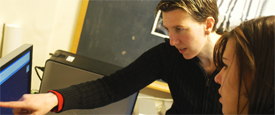Catching Waves in the ERP Lab

Images pop up in quick succession on the computer monitor. An eight-year-old, wearing a multicolored, electrode-studded cap connected to the computer system that makes up Hampshire's Event Related Potential (ERP) lab, watches each picture go by.
 |
Welcome to the world of developmental cognitive neuroscience. That's the field Couperus specializes in, a relatively new cross between psychology and neuroscience that studies the way children's brains develop.
"My position is not something you generally find at a small liberal arts college. Typically it would be found at a big university," she says.
Couperus studies normal attention development in children between the ages of 6 and 18. The ERP lab, a small room tucked away in Adele Simmons Hall, is just one tool at her disposal as she attempts to make some headway into understanding some of the still very much mysterious ways in which the young mind works.
"We see certain waves, and know visual processing is going on. We see differences in the studies, and know the brain is doing something different," says Couperus. "We know so little about normal attention development. I would love to study abnormal development, but there is a lot of work yet to be done on this. Studies of ADHD, for instance, are not often based on an understanding of what normal attention is. We need to show exactly what's going on in kids normally first."
Sharing this passion for research with her students is something Couperus enjoys, especially since many have backgrounds in subjects other than science. She often helps them develop research projects related to their own cross-disciplinary studies, research that wouldn't necessarily fit in at a traditional research university but which, at Hampshire, is part of the emphasis on interdisciplinary work.
"None of my students are doing exactly what I'm doing," says Couperus. "Students tend to come in and have their own ideas which shapes my work and in turn my work shapes theirs."
Kristen Iodice, for instance, is using the ERP lab for a study on attention biases in smokers, ex-smokers, and nonsmokers. She has mostly enlisted fellow Hampshire students for the task, which took place over the 2009 January term.
"I'm seeing how smokers, nonsmokers, and ex-smokers respond to cigarette-related images, anti-cigarette images, and neutral images, how, on a neurological level, their brain responds," says Iodice, who plans on a career in psychology. "Basically I'm seeing what different people are going to pay attention to."
Experience in an ERP lab, says Couperus, is rare for undergraduates. While it is not as good as MRIs at determining the location of activity, ERP studies have phenomenal temporal resolution, meaning they can tell us almost exactly when something happens. While MRIs tell us when things happen down to about four seconds of error, ERPs tell us within 10-15 milliseconds. Students who become familiar with the techniques of ERP research often receive job offers by labs across the country that give them a valuable leg up when they apply to graduate school.
"This just doesn't happen at many schools," says Couperus. "Working in this lab really puts students ahead in the field."
And down the line, it may end up shedding a little more light on the complex inner workings of the human mind.

